Decluttering your body
- Ellen Storm
- Feb 16, 2023
- 4 min read
Updated: May 30, 2023

Rather bizarrely, I devised the food addiction staircase while I was busy de-cluttering my house. Feeling totally overwhelmed by the amount of stuff I had accumulated during 13 years of parenthood, I started reading a book called The Life-Changing Magic of Tidying by a Japanese woman called Marie Kondo (2014). In it, Marie advocates tidying your house completely and all in one go. This is not an overnight process, but it is not one drawn out over years either. Marie suggests six months to completely transform your home forever, and she points out that once her clients have learnt the skills they need to keep their things in order, they never relapse back to their previous state of clutter. In the case of tidying, these skills are simply how to decide what to keep and what to throw away, and for those things you decide to keep, how to store them.
It occurred to me that tidying up my food-cluttered body and mind should follow a similar process. I wanted to finish the process of cleaning my house with a similarly clear head and energetic body. This was a state I had experienced many times before during various attempts of the kinds I have described elsewhere (the overnight approach, the meal-by-meal approach, the gradual increase approach), but at the point at which I decided to de-clutter my house, my diet had once again also become ‘cluttered’ with all sorts of things that didn’t serve me: things that I knew were making me ill.
The U-Turn Health process is a process of taking each food item in turn and deciding whether to keep it (in your diet) or whether to throw it away (you may need to physically stand and hold that tub of Himalayan pink salt for some time). It is about learning the basis for making sound judgements in this regard, and learning how to let go. Letting go of foods to which we may have strong physical and emotional attachments is not an easy process, but as with tidying, the more we do it the better we get at doing it. The more we are able to release the addictive foods that are keeping us trapped and making us ill, the cleaner and clearer our bodies and minds will become.
We live in a world that wants us to buy things. We are constantly being incited to buy both food and non-food items that we don’t really need. When we decide to clear the non-food items out of our house, or the food items out of our kitchen and our body, we have to learn to do two things. Firstly we have to learn how to throw away the things we have bought that don’t serve us, and secondly we have to learn how to stop buying any more.
These are not easy things to do. If, like me, you were brought up not to waste food (because food is a precious gift to be grateful for, and there are starving children in Africa), you may find yourself repeatedly trying to eat up all the unwanted food in your house in preparation for the ‘big day’ when you will start your new life. The problem with this is that if you haven’t learnt how to stop buying these things, you will probably just go out and buy some more the very next day, especially if you start experiencing cravings and withdrawal symptoms (such as tiredness or agitation) that you have not recognised as such.
That is why I strongly recommend that on the day you have chosen to exclude a particular food group or addictive thing, that you actively throw away all the foods in the house that contain that thing and then take the rubbish bag out and put it in your wheelie bin. If you can’t do that because you live with other people with whom you share food, and those people are still eating that food, then at the very least make a separate shelf or box for that food and mentally mark it as ‘theirs not mine’. Draw a clear line of separation in your head, and if you need to then also tell them that you are no longer eating that food and that therefore that item is now theirs alone. Having told them that you are no longer eating that thing, if they then forget and buy that thing for you again because they know you like it but it isn’t something they would eat themselves, then you must politely but firmly thank them, remind them, and throw it away (or put it in the food bank if it is unopened). Under no circumstances should you eat it. If you eat it they will buy it again, you will eat it again, and you will be entirely lost. Apply the same rules to yourself. If you buy yourself a ‘treat’ (in a moment of weakness) but don’t eat it all, throw the rest away. Politely but firmly thank yourself, remind yourself, and throw it away.
Ellen Storm, 23rd November 2022.










Comments